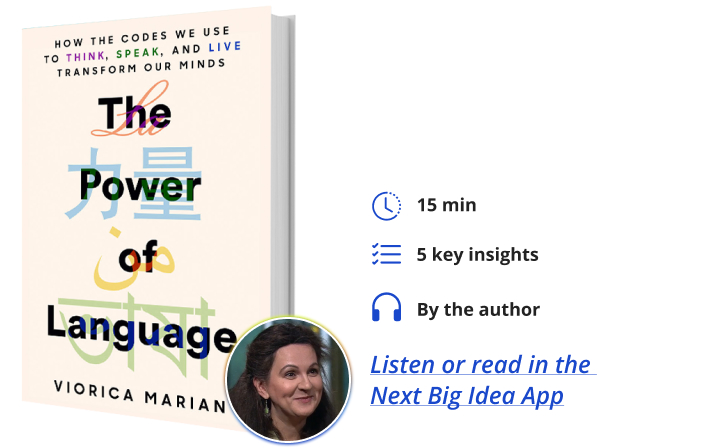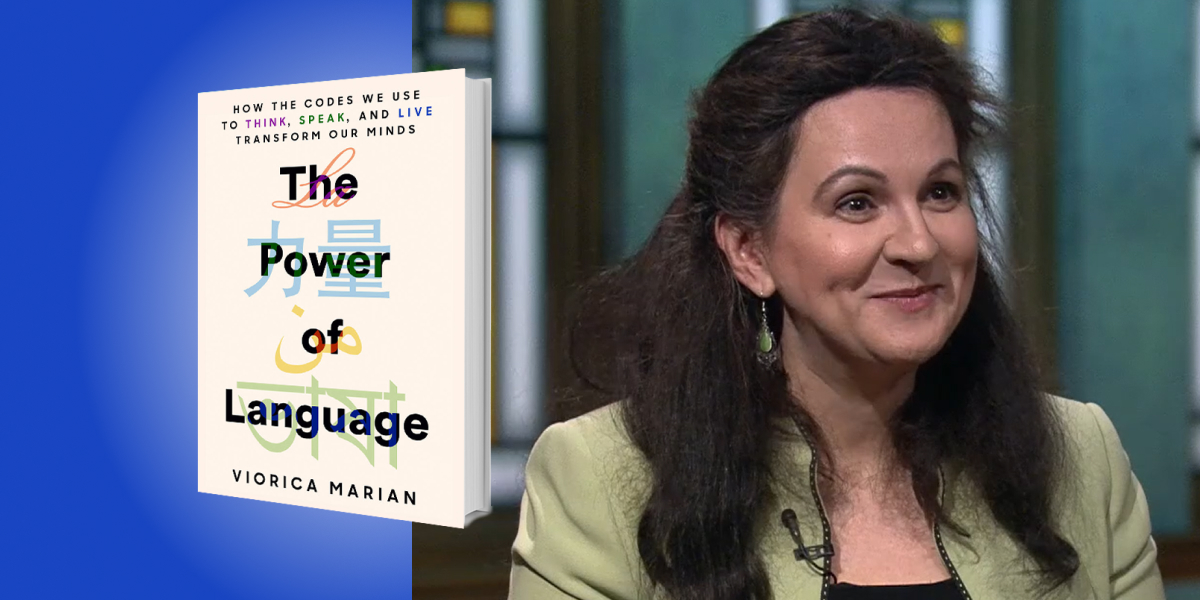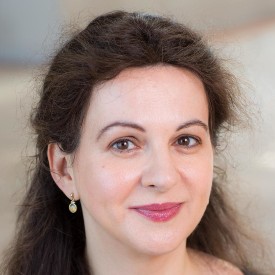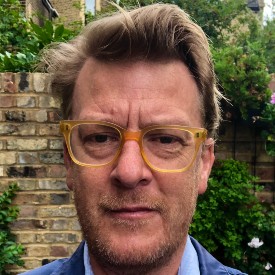Viorica Marian is the Ralph and Jean Sundin Endowed Professor of Communication Sciences and Disorders and professor of psychology at Northwestern University. Since 2000, Marian has directed the university’s Bilingualism and Psycholinguistics Research Lab, receiving funding from the National Institutes of Health and the National Science Foundation.
Below, Viorica shares 5 key insights from her new book, The Power of Language: How the Codes We Use to Think, Speak, and Live Transform Our Minds. Listen to the audio version—read by Viorica herself—in the Next Big Idea App.

1. The majority of the world’s population is bilingual or multilingual.
It is very common for people all over the world to grow up speaking two or more languages or dialects from childhood and learn additional languages later in life. Yet most scientific studies of the mind focus on monolinguals and exclude bilinguals and other linguistically diverse groups from research samples. The assumption continues to be that those who know two or more languages are deviations from the norm, and multilingualism is viewed as noise rather than as the signal.
This is reminiscent of the medical approach just decades ago of studying heart disease and diabetes exclusively in white males, only to discover later that heart disease manifests differently in women, and that sugar is processed differently in populations indigenous to North and South America. In the same way, studying the human mind only in monolinguals provides not only a limited and incomplete understanding of humanity’s potential, but an inaccurate, incorrect one.
2. How our brains perceive reality is shaped by the languages we know.
What is reality? We often assume that there is an objective world out there that surrounds us and that we all universally agree on, when in fact that is not the case. Reality as each of us perceives it is a subjective experience that results from how our brains combine the input from our senses with previous knowledge and experience.
What we perceive as reality is essentially brain activity. Different languages activate somewhat different neural networks, and those who speak multiple languages have somewhat different neural networks activated by each language.
We’re used to accepting that the same environmental input can elicit different emotions across people, but we find it difficult to accept that the same environmental input can elicit different sensory experiences. The truth is that both emotions and senses can vary across individuals in response to the exact same stimulus. They can even vary within an individual across time depending on recent experience, including language experience.
You may have come across the visual illusion where some people see a dress as black and blue while others see the same dress as white and gold, or you may have come across auditory illusions where the same sound is heard as something different at various times. Sensory perception can be altered by anything from the surrounding visual context to the languages we speak. What we see or hear is determined by which neurons are most likely to fire, and which neurons are most likely to fire is tied to past neural firings.
“Every new language we learn makes us extract and interpret information differently.”
If you’ve ever played Boggle, turning the grid may have changed your perspective and made you see the same letters in a different way, allowing you to extract more words and raise your score. Like a turn of the Boggle board, every new language we learn makes us extract and interpret information differently. The brain provides different answers depending on how the incoming input is organized, and language is one of the most powerful ways to organize, process, and structure information.
We are just beginning to understand the multilingual mind. Why? Because science has been playing Boggle without turning the board.
3. Learning a second language and becoming bilingual transforms our minds.
Learning a second language changes our brains and our identities, including how we feel, what we remember, the decisions we make, and the ideas and insights we have across languages. Bilingual people become slightly different versions of themselves when they switch languages. You may have heard the saying, “To know another language is to possess another soul.”
Knowing another language changes how we perceive the world not only figuratively, but also quite literally, down to the mechanics of our eye movements. For example, it is well-known in psycholinguistics that words that share form or meaning are co-activated in the mind. When an English speaker is being told to pick up a marker and there are marbles on the desk, they are likely to make eye movements toward the marbles because marker and marbles share word onset. When you speak another language, form overlap can be not only within a language, but also across languages. In experiments using eye tracking, we find that if you are a Russian-English bilingual and you’re told to pick up a marker, you are likely to make eye movements to a stamp because the Russian word for stamp is marka, and the English word marker and Russian word marka share form. What this tells us is that what our eye movements are drawn to, what captures our attention, and what our brains register depend on the languages we know.
In other experiments, we see that languages also influence what we later remember. Russian-English bilinguals are more likely to remember that there was a stamp on that desk where they looked for a marker than English monolinguals. Speakers of different languages not only see but also remember things differently.
They even make different decisions across languages. In one version of the classic trolley dilemma used to study morality, a trolley is speeding toward five workmen who cannot see it. You are standing on a bridge above a train track next to another person. If you push this person off the bridge onto the tracks below, the person will die, but this will stop the trolley, saving the five workmen. Is it permissible to sacrifice the life of one person to save the lives of five people?
“Speakers of different languages not only see but also remember things differently.”
When responding in a native language, 20 percent of bilinguals said that sacrificing one person to save five was permissible. When responding in a second language, 33 percent of bilinguals said so. This 13 percent change in decision-making resulted simply from shifting to a second language. This is known as the “Foreign Language Effect,” and it suggests that people make decisions that are more rational and utilitarian and less emotional in a non-native language in a variety of settings, ranging from ethics to finances.
4. Multilingualism changes us at the broader level as a society.
Here there are two examples—one is healthy aging. Several variables are known to contribute to healthy aging, most notably exercise, nutrition, and education. Bilingualism is another factor that has been shown to provide protection against the cognitive declines that are sometimes associated with aging and that are characteristic of dementia.
The incidence of Alzheimer’s is lower in multilingual societies. Countries in which the mean number of languages spoken is one have a higher incidence of Alzheimer’s than countries in which two or more languages are spoken. The incidence of Alzheimer’s continues to decrease with each additional societal language, with a direct correlation between the number of languages in a country and the incidence of Alzheimer’s disease.
This is one of the most striking recent discoveries in the neuroscience of multilingualism. Knowing more than one language delays Alzheimer’s and other types of dementia by four to six years on average.
Imagine taking a certain road home every day after work for many years until one day the road that takes you home collapses, and that route is no longer available to you. If you live in an area where more than one road has been built over time, the collapse of one road will not prevent you from reaching your destination because you can take alternative routes. But if that is the only way that exists to your home, or the only way you know, then you have a problem. In the same way, if one pathway in the brain has decayed and is no longer available for accessing memories or information, a bilingual has other pathways that have been built over time as a result of the links between words, memories, and experiences accumulated across two languages.
For the second example, I’ll draw upon a story from my children’s childhood that other parents may recognize. When my children were about two years old, I would surprise people with conversations like this: “What’s four minus two?” I would ask. “Two,” my toddler would answer. “What’s 81 divided by nine?” “Nine.” “What’s 55 multiplied by zero?” “Zero.” My toddler seemed to know everything. How? Well, I was able to use what I knew about language development to get the answers I wanted.
You see, I had constructed the questions so that the last word was always the correct answer. At a certain stage of language development, children repeat the last word they hear when presented with a choice. For them, this is part of the word-learning process.
“Knowing more than one language delays Alzheimer’s and other types of dementia by four to six years on average.”
Just like I used my knowledge of psycholinguistics with my kids, so do politicians, advertisers, lawyers, co-workers, and even family members use language to manipulate their audience. People are paid a great deal of money to manipulate language in a way that makes you buy specific products, vote a particular way, or render certain verdicts. Different things come to mind when you hear “right to life” than “right to choose,” and you are more likely to vote against a “death tax” than an “estate tax.”
In experiments, speakers of two languages were better at detecting manipulative language. When hearing sentences like “More people have been to London than I have” or “More men have finished school than he has,” bilinguals were more accurate in spotting the misleading wording. Multilingual experience seems to make people less susceptible to being manipulated by language.
Engaging with a variety of languages gives us crucial abilities that the human race will need to heal social discord and formulate solutions to looming global problems.
5. Knowing multiple codes of communication may hold the key to humanity’s future.
Languages are symbolic systems. We use words as symbols for mental concepts we want to represent and communicate. While you may not realize it, your mind already uses multiple symbolic systems—math, music, spoken languages, sign languages, and computer languages. The human brain is built to accommodate multiple codes of communication, and as we learn them, doors open to new experiences and knowledge. We live in a world of codes. Some are as fluid as the mother tongue. Some expand like math beyond human experience.
Not only do we live in a world of codes, we are code. Our genetic code can be read in a universal language encoded in DNA base pairs. Like the language we use to combine a limited number of symbols (words, or letters, or other notations) into an unlimited number of thoughts and ideas, the DNA code combines a limited number of DNA pairs into complex and varied organisms and species that represent all life on this planet. There are many similarities between the languages we use and the genetic code of life.
The codes of the universe and our ability to learn them, will, to a large extent, determine humanity’s future. Multilingualism gives us a greater chance of finding answers and of formulating innovative questions. The connection between language and thought and the multilingual mind can be, at a minimum, a propeller that advances humanity to new heights, and at a maximum, the key to its survival. What will we, and our languages, do next?
To listen to the audio version read by author Viorica Marian, download the Next Big Idea App today:































